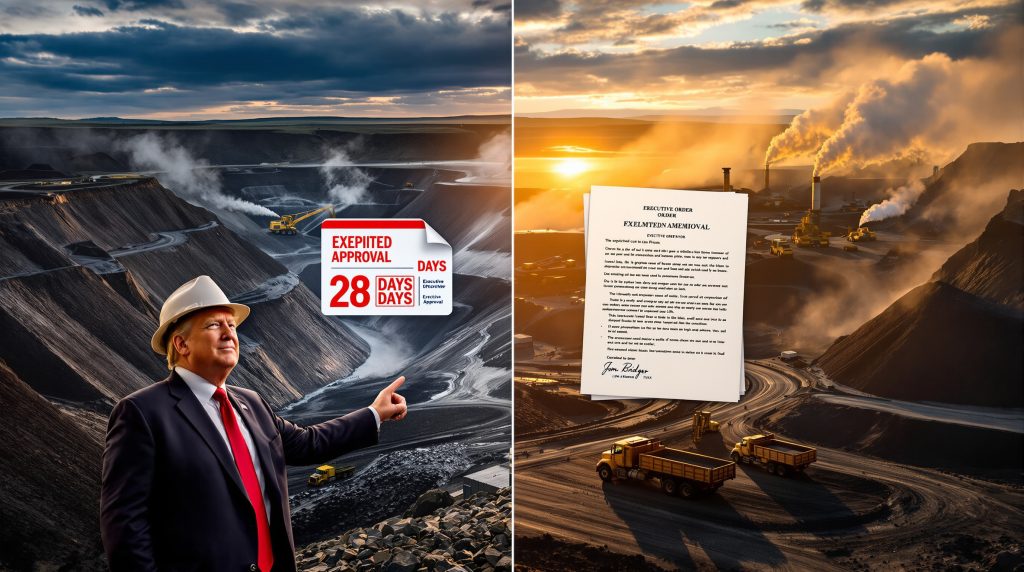What is the Black Butte Mine Expansion Project?
The Black Butte Mine expansion represents a significant development for Wyoming's coal industry, with regulatory approvals being fast-tracked through unprecedented emergency procedures. Operating in Sweetwater County since 1977, this longstanding mining operation primarily supplies thermal coal to the Jim Bridger Power Plant, Wyoming's largest coal-fired electricity generation facility.
The proposed expansion specifically targets Pits 10 and 15 under Federal Coal Lease WYW-6266, with ambitious goals that include:
- Accessing approximately 9.2 million tons of federal coal reserves
- Disturbing roughly 450 acres of land in southwestern Wyoming
- Extending the mine's operational life through at least 2039
- Supporting continued coal-fired operations at the Jim Bridger Power Plant
Since its initial application in 2014, this expansion project has navigated a complex regulatory journey, facing numerous delays and administrative obstacles before the current administration's intervention.
Project Scope and Timeline
The Black Butte Mine has been a cornerstone of Wyoming's energy infrastructure for decades, with the expansion representing a significant commitment to coal's continued role in the region's energy mix. The project's timeline alignment with the Jim Bridger Power Plant's operational projections through 2039 demonstrates the interconnected nature of coal mining and power generation in Wyoming's energy economy.
Technical assessments of the coal reserves indicate favorable characteristics for power generation, with the thermal coal's quality meeting the specific requirements of the Jim Bridger facility. This quality consistency has been a key factor in the longstanding relationship between the mine and power plant.
How Did the Trump Administration Transform the Approval Process?
The National Energy Emergency Declaration
On January 20, 2025, President Trump signed Executive Order 14156, declaring a national energy emergency that fundamentally altered the regulatory landscape for energy projects. This declaration empowered federal agencies to "identify and exercise any lawful emergency authorities available to them" to accelerate domestic energy resource development, with particular emphasis on coal.
The emergency declaration specifically:
- Defined energy resources broadly to include coal, oil, natural gas, and other fossil fuels
- Excluded wind and solar energy from the prioritized framework
- Authorized compressed environmental review timelines
- Established alternative compliance mechanisms for environmental regulations
This declaration created the foundation for unprecedented acceleration of fossil fuel development projects, with coal receiving particular attention through subsequent policy initiatives.
Executive Order 14261: "Reinvigorating America's Beautiful Clean Coal Industry"
Building on the emergency declaration, Executive Order 14261 (April 8, 2025) created a comprehensive policy framework specifically targeting coal development:
| Key Provision | Implementation Requirement | Timeline |
|---|---|---|
| Designation of coal as a "critical mineral" | Qualify coal projects for expedited permitting | Immediate |
| Identification of coal resources on federal lands | Consolidated report from Interior, Agriculture, and Energy | 60 days |
| Removal of regulatory barriers | Identification of policies discouraging coal investment | 30 days |
| Revision of anti-coal policies | Consideration of rescinding transition-focused regulations | 60 days |
| Termination of the "Jewell Moratorium" | Publication of notice in Federal Register | Immediate |
| Expedited royalty rate reduction processing | Review of applications from federal coal lessees | Ongoing |
These executive actions created the regulatory foundation for the unprecedented 28-day environmental review timeline applied to the Black Butte expansion project, representing a dramatic shift in federal energy policy priorities.
What Makes the 28-Day Review Process Unprecedented?
The compressed 28-day environmental review timeline for the Black Butte expansion represents a dramatic departure from traditional regulatory procedures. Under normal circumstances:
- Environmental Assessments typically require up to one year
- Full Environmental Impact Statements generally take two or more years
- Public comment periods normally span 30-60 days
- Consultation with multiple agencies occurs sequentially
The emergency procedures implemented for Black Butte include:
- Completion of the entire environmental review within 28 days
- A virtual public scoping meeting on August 18, 2025
- Written comments due by August 21, 2025 (just three days after the public meeting)
- Deferred consultations and retroactive compliance obligations
- Streamlined documentation requirements
This accelerated timeline has raised significant questions about the thoroughness of environmental analysis and the adequacy of public participation opportunities.
Historical Context and Precedent
The 28-day review timeline for the Black Butte expansion contrasts sharply with historical mine expansion approvals. Similar projects typically underwent extensive analysis under the National Environmental Policy Act (NEPA), often requiring years to complete. The compressed timeline represents a new approach to energy project approvals that prioritizes rapid development over extended analysis.
Regulatory experts note that this accelerated process tests the boundaries of administrative law flexibility, potentially establishing precedents for future emergency-based regulatory actions across various industries.
What Economic Impacts Will the Expansion Create?
Employment and Regional Economic Effects
The Black Butte expansion carries substantial economic implications for Sweetwater County and surrounding communities:
- Potential reversal of recent workforce reductions (19 layoffs in November 2023)
- Stabilization of mining employment through 2039
- Economic multiplier effects supporting local businesses and services
- Maintenance of the regional tax base dependent on mining activity
For Wyoming communities heavily dependent on resource extraction, the extension of mine operations represents a significant economic stabilizer in an increasingly uncertain energy landscape.
Federal Revenue Considerations
The expansion presents a complex picture regarding federal revenues:
- Generation of coal lease payments and royalties from 9.2 million tons of federal coal
- Potential offset by legislation lowering federal payments
- Possible reduction in Wyoming's annual revenue by approximately $50 million
- Tradeoff between increased production volumes and decreased per-unit revenue
The fiscal implications extend beyond direct mining revenues to include broader economic considerations related to energy production, transportation infrastructure, and regional development.
Market Stability and Energy Security
The expansion's economic justification relies heavily on sustained demand from the Jim Bridger Power Plant:
- Alignment of mine and power plant operational timelines through 2039
- Partial conversion of the power plant to natural gas, reflecting broader energy market trends
- Potential for export opportunities to international markets
- Competitive pressures from lower-cost energy alternatives
Industry analysts note that the project's economic viability depends significantly on stable domestic coal demand and supportive regulatory policies, both of which face potential volatility in coming decades.
What Environmental Concerns Does the Accelerated Review Raise?
Ecological and Land Disturbance
The 450-acre expansion footprint raises several environmental considerations:
- Wildlife habitat disruption and ecosystem fragmentation
- Soil stability and erosion control challenges
- Long-term reclamation requirements and effectiveness
- Cumulative impacts when combined with existing mining operations
Environmental specialists emphasize that thorough baseline studies typically require seasonal data collection to accurately assess ecosystem impacts, making the 28-day review particularly challenging for comprehensive ecological assessment.
Climate and Atmospheric Impacts
The expansion's climate implications include:
- Greenhouse gas emissions from coal extraction activities
- Carbon dioxide release from eventual combustion of 9.2 million tons of coal
- Reduced time for comprehensive climate impact analysis
- Limited consideration of alignment with national climate commitments
The accelerated timeline potentially limits thorough analysis of these long-term atmospheric effects, raising questions about the balance between immediate energy needs and longer-term environmental considerations.
Water Resource Concerns
Water-related environmental issues present particular challenges:
- Groundwater disruption and aquifer impacts
- Surface water contamination risks
- Long-term hydrological alterations
- Limited time for comprehensive hydrological studies
Hydrologists note that understanding complex groundwater systems typically requires extended monitoring periods, making the compressed timeline potentially inadequate for thorough water resource impact assessment.
Regulatory Oversight Changes
The Trump mining permits order affects environmental oversight:
- Increased state authority over coal mining violation complaints
- Reduced federal environmental enforcement mechanisms
- Elimination of economic incentives for environmental performance improvements
- Compressed timeline for developing adequate protection measures
These changes collectively represent a significant shift in the regulatory approach to coal mining, with potential long-term implications for environmental protection standards.
How Does This Project Fit Within Wyoming's Energy Landscape?
Wyoming's Coal Production Context
The Black Butte expansion occurs within Wyoming's position as America's coal powerhouse:
- Wyoming produces approximately 40% of the nation's coal supply
- The Powder River Basin represents the state's primary coal-producing region
- Southwestern Wyoming's Green River Basin contains significant low-sulfur subbituminous coal
- Black Butte's production complements larger mining operations in the state
While the Black Butte operation is smaller than the massive mines of the Powder River Basin, it plays an important role in Wyoming's diverse coal production portfolio, particularly for regional power generation.
Regional Power Generation Dynamics
The relationship between Black Butte and regional electricity infrastructure reflects broader energy transitions:
- Jim Bridger Power Plant's partial conversion to natural gas mirrors national trends
- Coal-fired units scheduled to continue operating until 2039
- Increasing competition from renewable energy sources
- Changing grid requirements and flexibility needs
Energy analysts note that the mine expansion occurs during a period of significant transition in electricity markets, with implications for long-term coal demand and power generation economics.
State Economic Dependencies
Wyoming's economic reliance on coal creates significant implications:
- Coal severance taxes fund essential state services
- Mining employment supports rural communities
- Infrastructure investments tied to continued coal production
- Diversification challenges in transition scenarios
The Black Butte expansion represents both an extension of Wyoming's traditional economic model and a potential bridge to future economic diversification efforts, highlighting the complex relationship between resource extraction and state economic planning.
What Legal and Procedural Challenges Might Emerge?
Litigation Risks
The compressed review process introduces substantial legal vulnerabilities:
- Potential challenges under National Environmental Policy Act requirements
- Questions regarding adequacy of endangered species consultations
- Concerns about tribal consultation sufficiency
- Precedent-setting nature of emergency procedure implementation
Legal experts suggest that the accelerated timeline could face judicial scrutiny, particularly regarding whether emergency provisions appropriately balance statutory requirements with procedural modifications.
Procedural Compliance Questions
The emergency framework raises procedural concerns:
- Deferred consultations creating retroactive compliance obligations
- Limited opportunity for meaningful public participation
- Compressed timeline for agency review and coordination
- Questions regarding scientific rigor of accelerated assessments
Administrative law specialists note that the abbreviated process tests the boundaries of regulatory flexibility, potentially establishing significant precedents for future emergency-based actions.
Administrative Record Adequacy
Future legal challenges may focus on administrative record completeness:
- Documentation of decision-making processes
- Incorporation of public comments into final decisions
- Evidence supporting findings of no significant impact
- Justification for emergency procedure application
The adequacy of the administrative record created during the 28-day review will likely determine the legal defensibility of resulting approvals, with implications for both this specific project and future expedited reviews.
What Stakeholder Perspectives Shape the Debate?
Industry and Economic Development Viewpoints
Proponents emphasize economic and energy security benefits, with Adam Suess, Assistant Secretary for Land and Minerals Management, stating: "This mine expansion is about more than coal – it's about powering our grid, protecting our families, and putting American workers first."
Industry stakeholders highlight:
- Job preservation and creation
- Energy independence and reliability
- Federal revenue generation
- Regulatory certainty for investment
The economic narrative focuses on both immediate employment impacts and broader energy security considerations, positioning coal as an essential component of America's energy portfolio.
Environmental and Community Concerns
Environmental advocates raise significant concerns about the accelerated timeline and potential impacts:
- Insufficient time for thorough environmental analysis
- Limited public input opportunities
- Long-term ecological consequences
- Climate impact considerations
Environmental organizations emphasize that abbreviated reviews potentially compromise the quality of environmental protection measures, particularly for complex ecological systems requiring seasonal data collection.
Regional and National Policy Implications
The Black Butte expansion represents broader policy tensions:
- Balancing economic development with environmental protection
- Navigating energy transition timelines and impacts
- Addressing climate commitments while supporting traditional industries
- Setting precedents for future energy project approvals
Policy analysts note that the project serves as a microcosm of larger national debates about energy policy, climate change, and the appropriate balance between development and environmental protection.
What Does This Mean for the Future of Coal Development?
The Trump administration Black Butte Mine expansion represents a significant test case for the Trump administration's emergency energy procedures and coal revitalization strategy. By compressing a multi-year environmental review process into just 28 days, the administration has demonstrated its commitment to accelerating domestic energy production through regulatory streamlining.
This unprecedented approach creates a complex landscape of economic opportunities, environmental concerns, and procedural questions that will likely shape energy development policy for years to come. The expansion's progress will be closely watched by industry stakeholders, environmental organizations, and policy analysts as an indicator of the administration's ability to deliver on promises of energy dominance while navigating legal and regulatory requirements.
As the project moves forward, key questions remain about the adequacy of environmental protections, the economic viability of extended coal operations, and the precedent this sets for future energy project approvals. The expansion ultimately represents a microcosm of broader national debates about energy transition, climate policy, and the role of fossil fuels in America's energy future.
Broader Implications for U.S. Energy Policy
The Black Butte case study illustrates several critical dimensions of U.S. energy policy evolution:
- Tension between regulatory efficiency and environmental protection
- Balancing local economic benefits against broader environmental considerations
- Navigating the complex transition from traditional to alternative energy sources
- Establishing precedents for emergency-based regulatory actions
Energy policy experts suggest that the approach taken with Black Butte could signal a significant shift in how energy projects are evaluated and approved, with potential implications across the fossil fuel sector.
Industry Adaptation Strategies
The coal industry's adaptation to changing market and regulatory conditions is evident in the Black Butte expansion approach:
- Alignment with supportive federal policies
- Strategic focus on power plant-linked operations
- Long-term operational planning despite market uncertainties
- Utilization of emergency provisions to overcome regulatory hurdles
These strategies highlight the industry's continued efforts to maintain viability in an increasingly challenging market environment, leveraging policy opportunities to extend operational timelines. Furthermore, understanding mining permitting basics is essential for contextualizing the significance of the administration's regulatory changes.
The critical minerals order issued by the Trump administration further supports the coal industry by classifying coal as a critical mineral, creating additional pathways for accelerated approvals. Moreover, coal companies must carefully navigate corporate governance issues to avoid class action lawsuit governance challenges that could arise from environmental compliance questions.
Industry leaders like BHP have also been adjusting their approaches, with BHP's coal strategy 2025 offering insights into how major mining corporations are positioning themselves in the evolving energy landscape.
Disclaimer: This article contains forward-looking statements and analysis regarding energy markets, regulatory processes, and environmental impacts. Future outcomes may differ from projections based on policy changes, market developments, legal challenges, or other unforeseen factors. Readers should consider multiple perspectives when evaluating the complex issues surrounding energy development and environmental protection.
Want to Stay Ahead of Major Mineral Discoveries?
Discovery Alert's proprietary Discovery IQ model delivers instant notifications when significant ASX mineral discoveries are announced, giving you a crucial market advantage before the crowd catches on. Explore our dedicated discoveries page to see historic examples of exceptional mining investment returns and start your free 30-day trial today.




